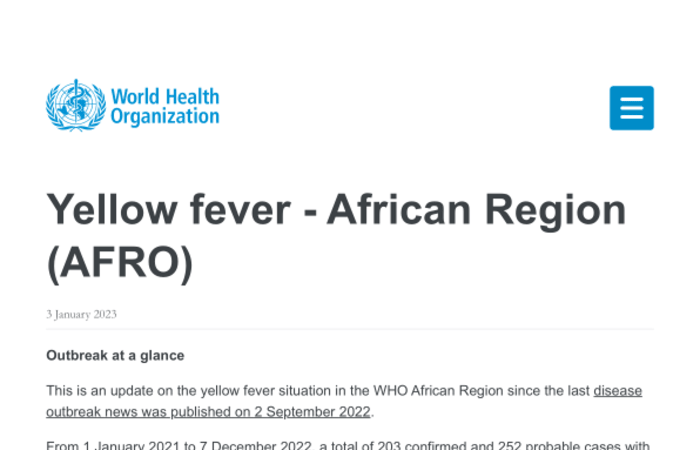Disease Outbreak News: Yellow fever – African Region (AFRO) (3 January 2023) – Ghana – ReliefWeb

Ghana + 12 more
Outbreak at a glance
This is an update on the yellow fever situation in the WHO African Region since the last disease outbreak news was published on 2 September 2022.
From 1 January 2021 to 7 December 2022, a total of 203 confirmed and 252 probable cases with 40 deaths (Case Fatality Ratio 9%) were reported to WHO from 13 countries in the WHO African Region.
Risk factors for further yellow fever spread and amplification include low population immunity, population movements, viral transmission dynamics, and climate and environmental factors that have contributed to the spread of Aedes mosquitoes. Recent Reactive Vaccination Campaigns increase population immunity and may have contributed to reducing the risk of yellow fever spread in targeted countries, resulting in a gradual downward trend in reported confirmed cases in 2022. However, the countries remain at high risk.
Description of the outbreak
In 2022, 12 countries in the WHO African Region have reported confirmed cases of yellow fever (Cameroon, the Central African Republic, Chad, Côte d’Ivoire, the Democratic Republic of the Congo, Ghana, Kenya, Niger, Nigeria, the Republic of the Congo, Sierra Leone and Uganda). Eight of these countries are experiencing a continuation of transmission from 2021 (Cameroon, the Central African Republic, Chad, Côte d’Ivoire, the Democratic Republic of the Congo, Ghana, Nigeria, and the Republic of the Congo) and four countries are newly reporting confirmed cases (Kenya, Niger, Sierra Leone and Uganda). One country, Gabon, reported an isolated confirmed case in 2021, but no further cases were registered in 2022.
Since 2021, a total of 203 confirmed and 252 probable cases with 40 deaths and a CFR of 9% have been reported. Of these, 23 deaths have been reported among confirmed cases (CFR among confirmed cases 11%) (Table 1). The high overall CFR among confirmed cases in 2021 (17 deaths, 11%) continued in 2022 (six deaths, 12%).
The male-to-female ratio among confirmed cases is not significantly different in 2021 and 2022 (1.3 and 1.6 respectively). The most affected age group amongst confirmed cases in 2021 was 10 years and below; meanwhile, the most affected group in 2022 is 20 to 30 years old. Overall, about 71% of confirmed cases are aged 30 years and below, and children aged 10 years and below are disproportionately affected.
According to the WHO/UNICEF Estimates of National Immunization Coverage (WUENIC), in 2021 routine immunization coverage against yellow fever in the African Region for childhood vaccinations was 48%, much lower than the 80% threshold required to confer population immunity against yellow fever, indicating the presence of an underlying susceptible population at risk of yellow fever and the risk of continued transmission. Country-specific estimates of vaccination coverage for 2021 are 54% in Cameroon, 41% in the Central African Republic, 45% in Chad, 67% in the Republic of the Congo, 65% in Côte d’Ivoire, 56% in the Democratic Republic of the Congo, 64% in Gabon, 94% in Ghana, 7% in Kenya, 80% in Niger (subnational introduction limited to four counties in 2021), 63% in Nigeria and 85% in Sierra Leone. Uganda has recently rolled-out yellow fever into the Routine Immunization programme.
Increasing population immunity through past and ongoing Preventive Mass Vaccination Campaigns (PMVC) supported through the EYE Strategy, and Reactive Vaccination Campaigns (RVC) have increased population immunity rapidly in implementing countries which has contributed to reducing the risk of spread of yellow fever in targeted countries. This may contribute to the gradual downward trend in reported confirmed cases in 2022, but should be noted that there is also variation in virus transmission dynamics that are difficult to predict.
Epidemiology of Yellow fever
Yellow fever is an epidemic-prone, vaccine-preventable disease caused by an arbovirus transmitted to humans by the bites of infected Aedes and Haemagogus mosquitoes. The incubation period ranges from 3 to 6 days. Many people do not experience symptoms, but when they occur, the most common are fever, muscle pain with prominent back pain, headache, loss of appetite, and nausea or vomiting. In most cases, symptoms disappear after 3 to 4 days. A small percentage of cases progress to a toxic phase with systemic infection affecting the liver and kidneys. These individuals can have more severe symptoms of high-grade fever, abdominal pain with vomiting, jaundice and dark urine caused by acute liver and kidney failure. Bleeding can occur from the mouth, nose, eyes, or stomach. Death can occur within 7 – 10 days in about half of cases with severe symptoms.
Yellow fever is prevented by an effective vaccine, which is safe and affordable. A single dose of yellow fever vaccine is sufficient to grant sustained immunity and life-long protection against yellow fever disease. A booster dose of the vaccine is not needed. The vaccine provides effective immunity within 10 days for 80-100% of people vaccinated, and within 30 days for more than 99% of people vaccinated.
Public health response
Surveillance and Laboratory.
Reactive vaccination
Preventive mass campaign vaccination
Prevention of International Spread and Points of Entry (PoE)
WHO risk assessment
Between 26 August 2022 and 29 November 2022, there have been 22 additional confirmed cases of yellow fever reported from ten countries. However, based on retrospective classification of the cases, there were only seven new confirmed cases and one death. Countries including Burkina Faso, Senegal and Togo have reported probable cases that were subsequently discarded, indicating that there is enhanced surveillance put in place. However, there is still persistent yellow fever virus circulation, as several of the recent confirmations have been from locations with little or no underlying immunity (e.g., near urban areas in Cameroon and Uganda; areas with no history of yellow fever vaccination such as Isiolo county, Kenya) hard-to-reach and under-served populations, including children that have been disproportionately impacted.
Based on the current situation of yellow fever in the WHO African region, the risk at the regional level was re-assessed as moderate on 12 December 2022 (high in November 2021 and June 2022) due to:
1. The decrease in the number of reported cases and the increasing population immunity, since there are ongoing and recent preventive vaccination campaigns, as well as reactive campaigns that have been organized in the affected countries, with more than four million people vaccinated in five countries (Ghana, Cameroon, Chad, the Central African Republic and Kenya), and an estimated 50 million people immunized during the PMVCs in 2021-2022 (Nigeria, the Democratic Republic of the Congo, the Republic of the Congo) supported by the EYE Strategy.
2. There is ongoing yellow fever virus circulation in some high-risk areas, the most recent cases, and outbreaks are reported in areas impacted by underlying risk factors, including gaps in routine immunization, missed special populations (e.g., nomadic or pastoralists and other mobile populations), security and access challenges.
3. Most confirmed cases were reported in the last quarter of 2021, however several of the recent confirmations have been from urban areas and/or locations with little or no underlying immunity (e.g., near urban areas in Cameroon and Uganda; areas with no history of yellow fever vaccination);
4. Case classifications, and response operations remain a challenge;
5. Delays in detection and investigation; delays in the implementation of previously planned PMVC, competing outbreaks and pandemics of COVID-19 and Mpox that are attracting more attention in yellow fever-affected countries, and security constraints in affected areas (the Central African Republic, far North of Cameroon, Eastern – the Democratic Republic of the Congo, and Northern Nigeria), population movement, all present risks that could lead to new yellow fever transmission.
The overall global risk remains low, as no cases related to this current outbreak have been reported at this stage outside of the African region. However, there are favorable ecosystems for yellow fever outside the African region, especially in the neigbouring countries in the WHO Eastern Mediterranean Region. There might be challenges in surveillance and immunization capacities due to the potential onward transmission through viremic travellers and due to the presence of the competent vector, if not detected in a timely way.
The impact on public health will persist until the ongoing outbreaks are controlled, vaccination coverage is high and immunity gaps in the population are closed. The importation of cases to countries with suboptimal coverage and persisting population immunity gaps poses a high risk and may jeopardize the tremendous efforts invested to achieve elimination.
WHO advice
Transmission can be amplified in circumstances where the Aedes mosquitos (day feeder) are present in urban settings and densely populated areas causing rapid spread of the disease.
Surveillance: WHO recommends close monitoring of the situation with active cross-border coordination and information sharing, due to the possibility of cases in neighboring countries. Enhanced surveillance with investigation and laboratory testing of suspect cases is recommended.
Vaccination: Vaccination is the primary means for the prevention and control of yellow fever. Yellow fever vaccines approved by WHO are safe, highly effective, and provide life-long protection against infection.
The countries reporting yellow fever cases and outbreaks are all high-priority countries for the EYE Strategy. The EYE Strategy recommends that all high-risk countries introduce yellow fever vaccination into their routine immunization (RI) schedule for those aged 9 months (Ethiopia, South Sudan have yet to introduce it into RI). Review of the risk analysis and scope of immunization activities to protect the population could help avert the risk of future outbreaks (e.g. Kenya).
To protect populations in high-risk areas in the longer term, it is important to continue the roll-out of Preventive Mass Vaccination Campaigns (PMVCs) and bolster Routine Immunization (RI), as well as take steps to strengthen the application of International Health Regulations (IHR 2005) and bolster surveillance for rapid detection aligned to EYE objectives.
WHO recommends vaccination for all international travellers, aged 9 months and older, going to areas determined by the WHO Secretariat as at risk for yellow fever transmission and for additional areas the recommendation for vaccination of international travellers is subject to the assessment of the likelihood of exposure of each individual traveller.
Yellow fever vaccination is safe, highly effective and a single dose provides life-long protection. Yellow fever vaccination is not recommended for infants younger than 9 months, except during epidemics when the risk of yellow fever virus transmission may be very high. The risks and benefits of vaccination in this age group should be carefully considered before vaccination. The vaccine should be used with caution during pregnancy or breastfeeding. However, pregnant or breastfeeding women may be vaccinated during epidemics or if travel to a country or area with a risk of transmission is unavoidable.
According to the provisions of the International Health Regulations (IHR), any country may decide to implement the requirement for proof of vaccination against yellow fever for arriving travellers. For international travel purposes, the proof of vaccination against yellow fever is only valid if recorded in the International Certificate of Vaccination or Prophylaxis. The International Certificate of Vaccination or Prophylaxis becomes valid 10 days after vaccination against yellow fever and extends for the life of the person vaccinated with a WHO-approved vaccine. A booster dose of the yellow fever vaccine cannot be required of international travellers as a condition of entry.
Vector control: In urban centres, targeted vector control measures are also helpful to interrupt transmission. As a general precaution, WHO recommends avoidance of mosquito bites, including the use of repellents and insecticide-treated mosquito nets. The highest risk for transmission of yellow fever virus is during the day and early evening.
Risk communication: WHO encourages its Member States to take all actions necessary to keep travellers well informed of risks and preventive measures including vaccination. Travellers should be made aware of yellow fever symptoms and signs and instructed to rapidly seek medical advice if presenting signs and symptoms suggestive of yellow fever infection. Infected returning travellers may pose a risk for the establishment of local cycles of yellow fever transmission in areas where a competent vector is present.
International travel and trade: WHO advises against the application of any travel or trade restrictions to the Region.
The updated areas at-risk for yellow fever transmission and the related recommendations for vaccination of international travellers were updated by WHO on 1 July 2020; the map of revised areas at risk and yellow fever vaccination recommendations is available on the WHO International Travel and Health website.
Further information
Citable reference: World Health Organization (3 January 2023). Disease Outbreak News; Yellow fever in East, West, and Central Africa.Available at: https://www.who.int/emergencies/disease-outbreak-news/item/2022-DON431
Nigeria
Nigeria
Uganda + 46 more
DR Congo + 46 more
ReliefWeb’s Terms & Conditions.
© 2023 all rights reserved.
Related Platforms
Other OCHA Services







